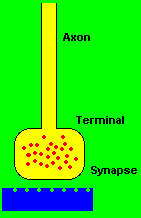|
|
|
Studies and Additional Information
To view the following files you need
Adobe Acrobat Reader -
Download
|
|
Neurotransmitters

Communication of information between
neurons is accomplished by movement of chemicals across a small
gap called the synapse. Chemicals, called neurotransmitters, are
released from one neuron at the presynaptic nerve terminal.
Neurotransmitters then cross the synapse where they may be
accepted by the next neuron at a specialized site called a
receptor. The action that follows activation of a receptor site
may be either depolarization (an excitatory postsynaptic
potential) or hyperpolarization (an inhibitory postsynaptic
potential). A depolarization makes it MORE likely that an action
potential will fire; a hyperpolarization makes it LESS likely
that an action potential will fire.
A neurotransmitter is the smallest
of the informational molecules that transmits an impulse from
one nerve cell to one or more neighboring cells across a
junction called a synapse. Neurotransmitters are stored in
vesicles (little containers) at the ends of neurons. When these
neurotransmitters reach the receptors of other neurons, a
complex cascade of effects may result, such as increased heart
rate, changes in mood, perception, and thought.
Neurotransmitters can also affect
the sensitivity of neurons, making them more or less reactive to
impulses.
The brain has a limited quantity of
any neurotransmitter available at any given time. After having
been released for use and having completed its task, the
neurotransmitter is rapidly destroyed or recycled and stored for
later use. If neurotransmission were not limited in this way,
the brain might race out of control, virtually burning itself
out. Because neurotransmitters must be made ongoing, the brain
must continually renew its supply of raw materials, such as
amino acids, vitamins, and minerals, which it needs for
manufacturing more neurotransmitters as well as the fuel (i.e.,
glucose and oxygen) that it needs to function and the
antioxidants that it needs for protection.
If neurotransmitter precursors, the
raw materials from which we make these vital nervous system
messengers, are in short supply, problems in perception,
behavior, cognition, and mood will result. Amino acids, the
building blocks of protein, are the most important of the
neurotransmitter precursors. The brain uses some of the
unaltered amino acids as neurotransmitters, directly. Glutamate,
aspartate, and glycine are three such amino acids. It builds
other neurotransmitters by altering the amino acids slightly
and/or combining them with other substances.
An example:
In order to make the dopamine and
norepinephrine, two neurotransmitters that may be deficient in
some children, the brain must have adequate supplies of amino
acids, vitamin B6, and iron. If a child does not take in and
properly absorb these nutrients, he or she will not have what is
needed to make enough dopamine and norepinephrine.
-
The amino acid tyrosine is found
in the nerve cells of the brain.
-
Tyrosine is transformed into
L-dopa only in the presence of enzymes, folic acid, niacin
(vitamin B3), and iron.
-
L-dopa is changed into dopamine in
the presence of vitamin B6.
-
Norepinephrine is finally made
with the assistance of vitamin C.
As the above example illustrates,
proteins alone are not sufficient. A host of cofactors are
critical in a child's diet in order to manufacture the proper
brain chemicals and structures that support optimal mood,
cognition, and behavior.
Some neurotransmitters:
-
Dopamine
-
Acetylcholine
-
Norepinephrine
-
Serotonin
|
Source: "Neurotransmitters for Kids"; Eric H. Chudler,
Ph.D.; University of Washington; Seattle, Washington
98195-6540 |
Descriptions taken from the University of Washington
Research Center
|
The action of
neurotransmitters can be stopped by four different
mechanisms |
| 1.
Diffusion: the neurotransmitter
drifts away, out of the synaptic cleft where it can no
longer act on a receptor. |
Diffusion
 |
| 2.
Enzymatic degradation (deactivation):
a specific enzyme changes the structure of the
neurotransmitter so it is not recognized by the receptor.
For example, acetylcholinesterase is the enzyme that breaks
acetylcholine into choline and acetate. |
Enzymatic degradation
 |
| 3.
Glial cells: astrocytes remove
neurotransmitters from the synaptic cleft. |
Astrocyte
Image courtesy of Biodidac
|
| 4.
Reuptake: the whole
neurotransmitter molecule is taken back into the axon
terminal that released it. This is a common way the action
of norepinephrine, dopamine and serotonin is stopped...these
neurotransmitters are removed from the synaptic cleft so
they cannot bind to receptors. |
Reuptake
 |
|
Source: Jeffrey Bruno, Ph.D.; Peninsula Child & Youth
Assessment Clinics; 80 Eureka Square, Suite 215; Pacifica, CA
94044 |
|